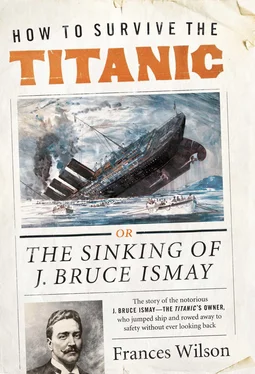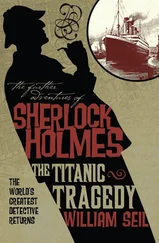After two months in Marseilles, Conrad had his first experience aboard a ship, crossing to Martinique and Haiti on the Mont Blanc, a three-masted wooden barque. He went out as a passenger and returned as a member of the crew; from mixing with the Polish intelligentsia, he was now mucking in with French sailors. In his autobiographical writings, such as The Mirror of the Sea, Conrad would idealise these early years, picturing himself as the hero in a book, dabbling in gun-running along the Spanish coast, losing in love, feeling alive in his youth as never before or since. The tales of gun-running are quite possibly a fantasy and there is no evidence that Conrad was emotionally or spiritually transported by his early voyages. Instead, despite a healthy allowance from Bobrowski, he quickly fell into debt and despair and in 1878 he shot himself through the chest. The bullet, remarkably, went ’durch und durch, narrowly missing the heart and not damaging any internal organ. Bobrowski, who rushed over from Poland to rescue his nephew, found him to be ‘extremely sensitive, conceited, reserved and in addition excitable’. He sorted out his debt and put him back on the rails. Conrad’s inability to handle his finances was to be a perennial problem for Bobrowski who, when asked again by him for money several months later, reminded the young man that ‘you were idling for nearly a whole year, you fell into debt, you deliberately shot yourself — and as a result of it all, at the worst time of the year… and in spite of the most terrible rate of exchange — I hasten to you, pay, spend about 2,000 rubles’.
Several months after his suicide attempt, Conrad set foot in England for the first time when his steamer, the Mavis, landed in Lowestoft on 10 June. Already fluent in French, he began to learn English from the daily papers and ‘from East Coast chaps, each built to last forever and coloured like a Christmas card’. He joined the British Merchant Navy and between 1880 and 1883 he sailed in Eastern waters, ‘the place from which I have carried away into my life the greatest number of suggestions’. ‘Karain’, Lord Jim, Youth and ‘The Secret Sharer’ are all products of this period. In 1883 he took of a passage to Liverpool on a steamer; in 1886 he gained his Master Mariner’s certificate and became a British subject, and in 1889 he went to the Congo from where he returned a different man. ‘I am still plunged in the deepest night,’ he wrote, ‘and my dreams are only nightmares.’ Still recovering from his breakdown, in 1891 he became first mate of the Torrens, one of the most famous clippers of the day, which ran a swift passage between London and Adelaide. The Torrens was, Conrad recalled in his essay, ‘The Torrens: A Personal Tribute’, ‘a ship of brilliant qualities — the way [she] had of letting big seas slip under her did one’s heart good to watch. It resembled so much an exhibition of intelligent grace and unerring skill that it could fascinate even the least seamanlike of our passengers.’ The ship, with her cargo of ‘a cow, a calf, and a good many sheep, geese, turkeys, ducks, hens, pigs… a kangaroo, two wallabies, five parrots, a dog, two cats, several canaries, and two laughing jackasses’, was a veritable ark. The Torrens would be Conrad’s only experience of working on a passenger ship and while he had a dislike of the general public, he now for the first time met educated Englishmen who spoke like Jim, using words like ‘by Jove’, ‘ripping’ and ‘bally ass’.
In March 1893, the Torrens sailed from Adelaide with two new passengers. Ted Sanderson and John Galsworthy, both twenty-five, were returning from adventures in New Zealand, Australia and the South Seas, where Galsworthy had been sent by his parents in the hope that he might recover from what they considered to be an inappropriate love affair. Sanderson, accompanying his friend, was going home to Elstree where he was to help the Reverend Lancelot Sanderson run the family’s prep school, while Galsworthy was reluctantly returning to his studies at the Admiralty bar. Both men had wanted to encounter Robert Louis Stevenson, now living in Samoa, whose novel Treasure Island they had read as teenagers. Published ten years earlier, Treasure Island told the story of another Jim who was faced with a jump:
‘Jump’, the Doctor orders Jim Hawkins. ‘One jump, and we’re out, and we’ll run for it like antelopes.’
‘No,’ Jim replies. ‘You know right well you wouldn’t do the thing yourself — neither you nor squire nor captain: and no more will I.’
Jim Hawkins is one of the heroes Conrad’s Lord Jim dreamed of becoming when, as a boy in his country parsonage, he was reading himself into ruin.
Galsworthy and Sanderson missed meeting Stevenson, but met Conrad instead. The Pole’s ‘rare personality attracted us at once’, Ted Sanderson wrote, ‘and a friendship was begun which lasted unbroken until death’. For Galsworthy, the experience of talking to Conrad ‘outweighed… all the other experiences of that voyage’. He remembered Conrad as ‘tanned, with a peaked brown beard, almost black hair, and dark brown eyes, over which the lids were deeply folded. He was thin, not tall, his arms very long, his shoulders broad, his head set rather forward. He spoke to me with a strong foreign accent. He seemed to me strange on an English ship. For fifty-six days I sailed in his company… Many evening watches in fine weather we spent on the poop. Ever the great teller of a tale, he had already nearly twenty years of tales to tell.’ During the evening watches, Conrad told tales of his own ‘romantic history’: Poland, the South Seas, gun-running in Spain. He was, Ted Sanderson said, ‘a fascinating talker on almost any subject’. Conrad’s great characteristic, Galsworthy concluded, was ‘fascination’. 14
Neither Conrad nor Galsworthy had yet become writers, but the manuscript of Conrad’s first novel, Almayer’s Folly, currently in the locker of his cabin on the Torrens, would be finished later that year at Elstree School. Here Conrad stayed for ten days as a guest of the Sanderson family, who immediately took to him. Elstree was Conrad’s ‘dear place’. ‘I have been made at home in Elstree,’ Conrad wrote to Agnes, one of Ted’s sisters, ‘by so much kindness; I am often there in my thoughts.’ 15The Sanderson household gave Conrad his first experience of family life, and he later dedicated The Mirror of the Sea to Katherine Sanderson, Ismay’s Mrs Kitty; his second novel, An Outcast of the Islands, about a man on the run from a scandal, he dedicated to Ted Sanderson. After Conrad married and started a family of his own, Sanderson promised his friend’s five-year-old son, John, a place at Elstree, but the boy went instead to Ferox Hall at Tonbridge, run by Ted Sanderson’s sister, Agnes. So by curious coincidence, the spot in which Ismay had been least happy, Conrad was most happy; the place where Ismay had first felt homesick, Conrad first felt truly at home.
This voyage on the Torrens was to be Conrad’s last. In no other kind of life, he said in Lord Jim, than that of the sailor ‘is the illusion more wide of reality — in no other is the beginning all illusion — the disenchantment more swift — the subjugation more complete’. Aged thirty-seven and already an exile, he made another standing jump, leaving his world of ships for life at a desk. It was now that Konradek transformed himself into Joseph Conrad, and began the process of extracting from his years at sea every drop of meaning, every ounce of significance, as though meaning and significance were what he feared these years may have lacked.
Читать дальше












